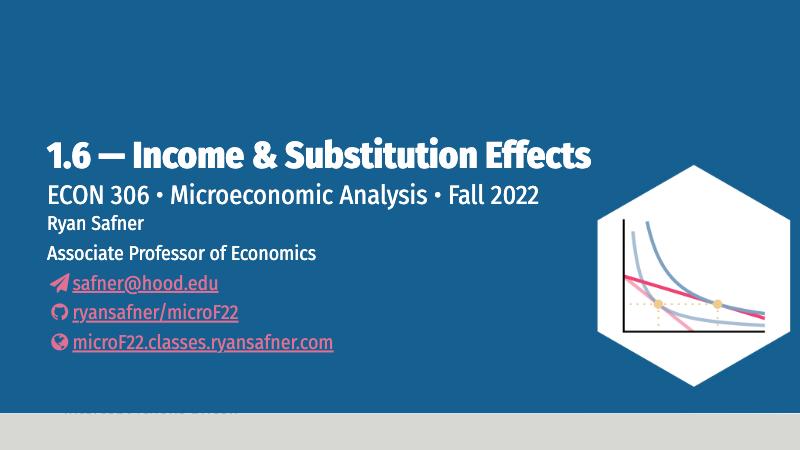1.6 — Income & Substitution Effects — Class Content
Problem Set 1 (on classes 1.1-1.4) is due by 11:59 PM Friday September 16 on Blackboard Assignments.
Overview
Today we cover the third effect in the individual demand function: the (own) price effect, aka the law of demand: how changes in a good’s (own) price affect quantity demanded for that good.
We introduce the idea of (simplified, own-price) demand functions, inverse demand functions, and a demand curve. I will also show you examples of how we derive demand functions and curves.
The other major concept today is breaking apart the law of demand into two effects: the (real) income effect, and the substitution effect. We considering them conceptually and graphically. These can be a difficult concept for students to grasp.
Readings
- Ch. 2.2, 5.3, in Goolsbee, Levitt, and Syverson, 2019
Interactive Examples
- Visualizing the Consumer’s Problem
- Visualizing Changes in the Consumer’s Problem
- Visualizing Demand Shifters
These are examples that I wrote in R/Shiny in the past, to visualize what it is we are looking at. As I find more time, I will update these and integrate them into our slides, but until then, I will just post links.
The first is a visual example of the static (one-time) Consumer’s problem. You can adjust things about the (Cobb-Douglas) utility function, income, and prices, and see how it would affect the graph and the optimum.
The second is a visual example of dynamic changes in the Consumer’s problem. The consumer starts at a pre-defined optimum. You can adjust any of the budget constraint parameters \((m, p_x, p_y)\), and see how it would affect a new optimum, which you can compare the the original optimum.
The third is a visual example of a hypothetical demand function for beer, with preference intensity, income, price of nachos (a complement), and price of wine (a substitute) as inputs to the function. Based on some pre-defined functions (in the background), you can change any of the inputs and see how it would affect the (inverse) demand function, expressed as a simple demand curve.
I hope some time to clean these up and make a few more, such as “Visualizing the Income and Substitution Effects” and “Estimating a Demand Function from Real World Data.”
Assignments
Problem Set 1 Due Friday September 16
Problem Set 1 (on classes 1.1-1.4) is due by 11:59 PM Friday September 16 on Blackboard Assignments.
Slides
Below, you can find the slides in two formats. Clicking the image will bring you to the html version of the slides in a new tab. The lower button will allow you to download a PDF version of the slides.
You can type h to see a special list of viewing options, and type o for an outline view of all the slides.
I suggest printing the slides beforehand and using them to take additional notes in class (not everything is in the slides)!
